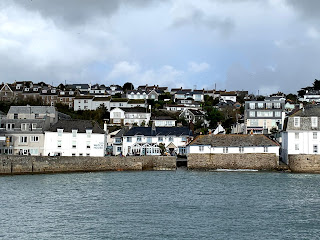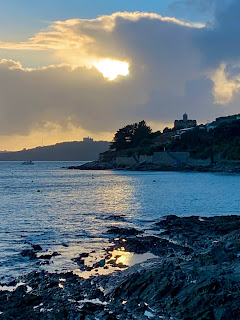If you asked Disney's "imagineers" to design the perfect Cornish holiday village, they'd probably come up with St. Mawes.
Regular readers will know that I prefer my beaches with warm waters and coral reefs. But if you can't manage the trek to palm trees and pina coladas, this tiny enclave on the southern tip of the Roseland peninsula is rather special.I've already described the charm of the location in my earlier story on places to stay. I didn't recommend the village's most famous hotel, Tresanton, but I'd happily return and give other options a try. The pure visual appeal of the place is the main reason why.
Look seaward for a sheltered bay bracketed by a lighthouse and a castle, with a busy channel beyond it dotted with an unceasing passage of sail and motorboat. Look inland for a ring of tidy, colourful houses climbing the encircling hill like well-dressed glitterati packing an amphitheatre. The village centre boasts a tiny harbour, which is mostly employed with ferries to Falmouth and other points on the Fal estuary, though piles of lobster pots and a fresh seafood stand attest that a few fishing boats still call this home. There are two traditional pubs and a wealth of independent boutiques, small galleries, hotels and restaurants that belie the resident population of just over 700. The reason, of course, is the holiday trade.
Much of Cornwall is dependant on tourism. But famous spots like St. Ives, Padstow and Penzance are on main roads, bustling with both residents and visitors, and can feel practically urban in high season. St. Mawes' position is more isolated. It's a solid 40 minutes by road from anything that wouldn't qualify as rural. (Don’t drive too fast on those roads or the local cops may catch you speeding. Trust me on this one.) A satnav's favoured route in may well take you by way of the King Harry Ferry. It's picturesque, but adds even more time as you're likely to have to wait for a crossing. St. Mawes' relative isolation gives it a calm, quiet, rural appeal. It's a destination to linger, not a base for extensive sightseeing.
Which is exactly what we did.
We didn’t move the car once in our three days there. You could easily while away a couple of weeks without straying far. Low tide exposes properly sandy beaches and I suspect the bay is shallow enough, and cut off enough from the main channel, to have the chance of warming to something above bone chilling in summer. There were actually wild swimmers in the bay during our late October visit, sans wetsuits. The surrounding Roseland peninsula is rich with countryside for walking. Some of England’s most famous sub-tropical gardens are nearby; a ferry in the harbour will take you up the river to the renown house and garden at Trelissick. If you want more urban excitement, Falmouth is just a 20-minute ferry ride across the estuary.
Here are our highlights.
THE CASTLE
Henry VIII worried constantly about French invasion, so invested in a chain of defensive castles along England’s east and south coasts. No self-respecting Renaissance monarch built anything ugly or unadorned, of course, and the “Henrician” castles prove the point. St. Mawes is a typical example, built of round towers intersecting each other. From the air they can look like a Venn diagramme, a cloverleaf or a flower, depending on your viewpoint.
Some have been adapted and turned into residences, like the wonderful Walmer Castle (which I wrote about here). St. Mawes’ Castle is mostly an empty shell. Though its English Heritage caretakers have ensured a sound roof over the central tower, the rooms inside are empty. The most picturesque bits are outside, anyway. Despite centuries of battering by salt-laden winds, some of the gargoyles and decorative accents remain, including part of a lavish inscription surrounded by angels celebrating Henry’s son, the future Edward VI.
The castle faces its sister fortification, Pendennis, in Falmouth. Between them, their firepower was designed to prevent any invading navy from getting up the River Fal. Something that, fortunately, no hostile force ever tried. The grounds are strewn with cannon. Military buffs will find both them and the earthworks interesting, and there’s loads of history here including chapters in the Civil War and World War II. But most visitors will simply appreciate taking in spectacular views from within the frame of magnificent architecture.
FALMOUTH
Town planners wringing their hands over the death of the high street should make a study of Falmouth, where a bustling stretch of pedestrianised high street is almost devoid of big chains. There are, instead, one-of-a-kind galleries, toy stores, clothing boutiques, home decorating emporiums and gift shops. Dining and drinking options are equally local, with family owned pubs, independent restaurants, gin emporiums and coffee shops. This being Cornwall there are, naturally, tea shops, chippies and pasty sellers, none of which we had a chance to sample during our time in the county because we never had room between our late, hearty breakfasts and our plentiful three-course dinners. We did spend some time drinking, however. The Stable, located in the historic Old Customs House, has a bewildering range of 50 ciders, many from small producers unavailable outside of the West Country.
Falmouth's affluent, independent high street no doubt owes much to the fact it's adjacent to a yacht harbour. Unsurprisingly, it reminds me a lot of the main drag in Cowes. Falmouth itself extends much further, and even without the traffic-blocking bollards it was obvious where the tourist area ended and "real" town began. Cue Boots, M&S and mobile network shops. But the picturesque heart near the harbour is a delight not to be missed, and just 20 minutes from St. Mawes on the ferry.
ST. JUST IN ROSELAND
We found this gem thanks to a hot tip from a regular visitor to the area. The church of St. Just is a small, 13th century building with a 15th century tower sitting in splendid isolation next to a tiny inlet where the St. Just creek flows into the Fal estuary. A deep quiet covers the scene, broken only by the cry of seagulls and the drip of various tiny streams ... including a holy well ... trickling toward the larger body of water. It would be easy to imagine yourself a Medieval pilgrim were it not for a few modern sailboats at anchor and a sprawling Victorian house across the water.
Such a pretty church in such a serene setting would be enough of a reason to visit, but St. Just's real glory is its churchyard. A steep slope rears up behind the building, thick with moss-covered tombstones and heavily planted with a dazzling mix of woodland and sub-tropical plants. most of the graves near the church are Georgian or Victorian, showing off a variety of sculptural styles and well covered by mosses. It astonishes me that none of the major Vampire movie franchises have found this place. It's a Gothic delight; like a miniature version of Highgrove Cemetery, with palm trees and ferns.
The car park and an adjacent tea shop are well out of sight of the prettiest scenes. A variety of hikes stretch out from here for those with more time than we had.
PUBS: THE VICTORY, THE HOUSE OF THE RISING SUN
Both of the pubs at the centre of St. Mawes are classics.
The Victory lies a short walk up a steep street running up from the harbour and is the simpler of the two. There's no fancy decor, the tables are simple wooden slabs and the photos on the wall aren't put there by a designer, but because they show the locals busy around the neighbourhood. Don't let the simplicity fool you; the people next to me were talking about how their Aga was fairing in their kitchen renovation and whether or not they were going to dry dock their yacht for the winter. The service here is fantastic; the publican remembered not only me, but my drink order, from my first visit and asked if I wanted another before I'd reached the table on my return.
The House of The Rising Sun is much bigger, and also a stone's throw from the harbour. Designers have staged this one a bit more, with a variety of rooms all sharing a jolly nautical theme. There's a large conservatory across the front of the building which is perfect for a blustery day. Thanks to the new pandemic-friendly ordering app, we could sit at our leisure, watch the weather turn from sun to rain and back again, and hit a few buttons on a phone to summon another round. Dangerous.
THE WATCH HOUSE
So good we ate there twice, this restaurant is one of our favourite memories of St. Mawes. A tremendously genial staff, local and seasonal produce, a small but surprisingly good wine list and a view of the water from which much of the menu came. Though there were meaty options, we all chose seafood both nights. Flavours ranged from the traditional ... fish and chips, fresh oysters, prawn cocktail ... to the slightly exotic ... Oriental-spiced fried squid with sriracha mayonnaise, Asian-inspired hake on a bed of spicy Dal. Locally made ice creams made a simple but appropriate ending. It's a shame that pandemic regulations demanded a 10 o'clock close at the time. This is the kind of place we would have loved to linger at for hours.









No comments:
Post a Comment